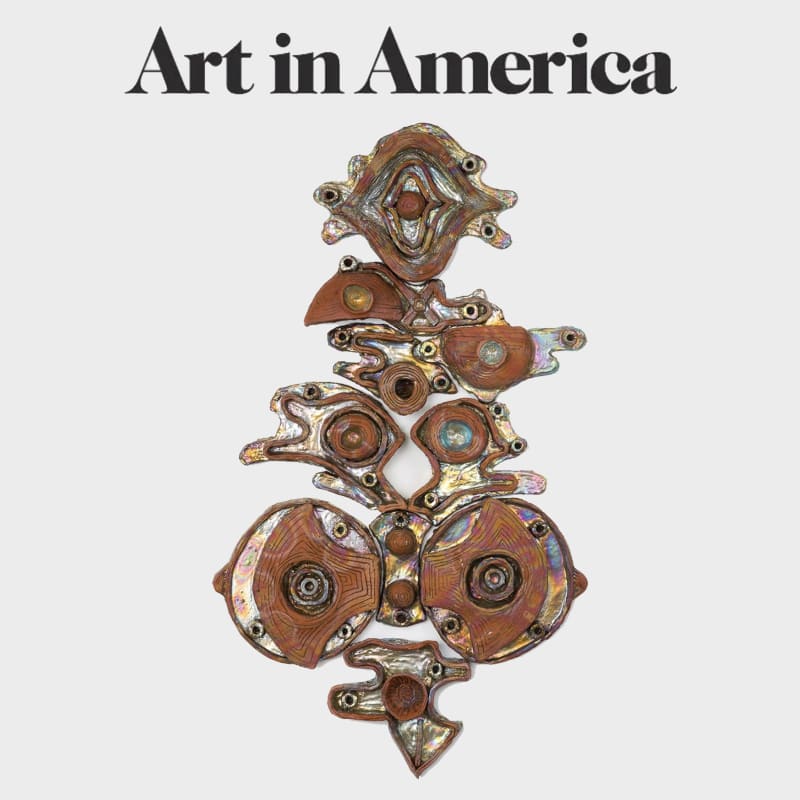Exerpt from Sculpture: An Art of Craft and Storytelling:
Ebitenyefa Baralaye, a Nigerian-born artist based in Detroit, shapes stately quasi-abstract ceramic heads that allude to the African American tradition of the face jug. Features are rendered in sinuous coils, a sort of drawing in clay, and lightly applied over the pronounced throwing rings of the vessel-like forms. In an interview for Art Journal, the artist told me that he is exploring “the way that facial features represent not just one person but a community, a society, and a culture.”
Baralaye emphasizes materiality too, choosing iron-rich strains of earthenware that index Black skin tones. “Clay is not a neutral substance,” he said. “It is a membrane that has specific characteristics and properties as well as a memory of the forces that acted upon it…. Its physical memory is like the experiences and trauma that we carry in our bodies, not always in visible marks and impressions but in a deeply physiological sense, in our shifting ability to cope, to be happy, to feel fulfilled, to be healthy.” Shot through with vulnerability and violence, the story of African Americans’ heritage is, at one level, all too familiar. But in his richly conceived and executed artifacts, Baralaye takes ownership of that narrative, remaking it into something empowering.
Similarly, New York–based artists Clementine Keith-Roach and Julia Kunin address fraught issues of gender. Keith-Roach’s vessels often seem to tell the story of their own becoming, with surrealistically disembodied hands applying light touches to the surface. The terra-cotta jars are found objects, sourced from Turkey and Greece—recent examples of the kind of trade items that have crisscrossed the Mediterranean since ancient times—while the added elements are jesmonite casts from the artist’s own body. This juxtaposition is modulated by the trompe l’oeil surfaces of the bodily elements, which Keith-Roach paints in imitation of the original ceramics’ patina, suggesting historical interchange and reciprocity.
In her newest works, Keith-Roach has further extended this vocabulary by working with large-scale basins and urns attached to casts of her own naked legs kneeling, reclining, or standing upright. Here, she is clearly responding to the sculptural nude, as well as the venerable analogy between the female body and a vessel, one destined to carry and nurture human life. Both of these conventions have served the interests of a sexist patriarchy, but instead of parodying that sort of objectification, Keith-Roach offers a feminine figuration that is explicitly celebratory.
The same is true of Julia Kunin’s multipart ceramic sculptures, in which lesbian erotic imagery is sheathed in iridescent splendor. Since 2009, Kunin has traveled annually to Hungary to work with technicians at Zsolnay, a large ceramics factory famed since the 19th century for its luster glazes. The only American to have recently worked in this context, Kunin has done so at a time when LGBTQ+ rights in Hungary are under concerted assault by the right-wing populist government of Victor Orbán.
In these seemingly inhospitable circumstances, Kunin has managed to create works of visionary jouissance. She draws equal inspiration from utopian feminist fiction—Charlotte Perkins Gilman’s Herland (1915) and Monique Wittig’s Les Guérillères (1969)—and from Zsolnay’s Art Nouveau period, a heyday for allegorical figures of nymphs and femmes fatales. Kunin adopts these stereotypes only to liberate them, breaking her figures apart into free-floating motifs that encode female identity: lips, vaginas, keyholes. There is clearly a rapport between her iconography and that of Portrait of a German Officer (1914), Marsden Hartley’s emblematic portrait of his gay lover, painted at a time when it was not safe to tell stories of queerness in public.
In the works of Baralaye, Keith-Roach, and Kunin, we see an inversion of the strategies of the postwar studio craft movement, in which craftspeople sought to transcend tradition in the hope of attaining fine art status. Today, many artists, free of old hang-ups about disciplinary classification, are boldly exploring craft’s multiple histories. Consider, for example, Beatriz Cortez, a Salvadoran artist based in Los Angeles. As part of “Futures” (a recent exhibition at the Smithsonian Arts and Industries Building in Washington, D.C., for which I served on the curatorial team), Cortez created Chultún El Semillero (2021), a futuristic pod the size of a one-person space capsule, hand-built in steel, and illuminated from within. Though it could almost be a science-fiction film prop, the piece is actually based on an ancient model. The chultunes made by the Maya of the Yucatán regionare stone cavities, laboriously carved out by hand and then used for long-term storage: time capsules of a sort, dedicated to the survival of the community. Cortez’s reimagination of this archaic practice—her sculpture was filled with tools and living plants and seeds—suggests that, at a time when ecological peril makes cross-generational care so vital, we would do well to attend to older mentalities.

